What is Ribd virus?
Ribd virus is a new variant of dangerous ransomware called STOP (Djvu). Although ‘Ribd’ variant was released recently, many users have already encountered a result of its malicious activity. It encrypts files located on the computer, and renames them appending .ribd file extension to their name. All encrypted files become useless, their contents cannot be read without decryption. The criminals behind this virus demand a ransom in exchange for a unique key and decryptor, which can decrypt the files and restore access to their contents. Fortunately, there is a free Ribd File Decrypt Tool, which in some cases can decrypt encrypted files. In addition to it, we have developed several methods for recovering the contents of encrypted files without a decryptor and a key. Scroll down to learn more about this decryptor and all ways to recover encrypted files.

Screenshot of files encrypted by Ribd virus (‘.ribd’ file extension)
QUICK LINKS
- What is Ribd virus?
- Threat Summary
- How to remove Ribd virus (ransomware)
- How to decrypt .ribd files
- How to restore .ribd files
- How to protect your PC from Ribd ransomware
- Video Guide
Ribd ransomware is a new malware that belongs to the STOP (Djvu) ransomware family. It encrypts files using a strong encryption algorithm. The virus uses a long key to encrypt files. This key is unique for each victim, therefore it excludes the possibility of using the same key to decrypt files on different computers. In some cases, when Ribd cannot establish a connection to its command server (C&C), it uses the so-called ‘offline key’. This key is the same for all victims. And most importantly, the security researchers have found a way to determine this key.

Ribd does not encrypt absolutely all files, as it will cause the computer to stop working. Therefore, it skips and does not encrypt Windows system files as well as files with the name ‘_readme.txt’ and files having the extension from the following list: .ini, .bat, .dll, .lnk, .sys. All other files on the victim’s computer will be encrypted. It makes no difference where the files are located, on a hard drive or cloud storage. If at the time of the ransomware attack a disk was connected to the computer, then all the files on it can be encrypted. In addition to the fact that Ribd virus does not matter where the files are located, it also does not matter what type of files they are. Files of all common types can be encrypted, including the following:
.rim, .ws, .snx, .bkf, .py, .xxx, .xx, .x3f, .m4a, .xar, .wire, .wmv, .xld, .tax, .docm, .rwl, .hkdb, .y, .bc7, .tor, .vfs0, .wsh, .xml, .wmo, .raw, .odm, .odc, .lrf, .m3u, .pptx, .dxg, .docx, .fos, .qic, .zip, .pak, .wn, .zi, .rofl, .raf, .x, .w3x, .bsa, .wri, .wps, .itm, .iwd, .itl, .dba, .wpw, .xmind, .t12, .iwi, .wsc, .icxs, .xll, .wpa, .wotreplay, .upk, .ods, .wmd, .nrw, .db0, .rb, .wp4, .wpd, .wot, .ybk, .xyw, .psk, .xlsb, .doc, .dwg, .wpd, .p7c, .rgss3a, .wav, .z3d, .rar, .hplg, .itdb, .hvpl, .ztmp, .wma, .xpm, .mdbackup, .wps, .avi, .3fr, .crw, .dmp, .3ds, .fpk, .xlk, .zdb, .mdb, .cer, .png, .odp, .cdr, .menu, .js, .pst, .das, .1st, .svg, .gdb, .crt, .x3d, .vtf, .xls, .big, .lbf, .sis, .bc6, .xlsx, .1, .kdc, .wbm, .sr2, .webp, .odb, .wbk, .sidn, .cas, .esm, .pdf, .indd, .sb, .zdc, .xlsx, .dng, .xdb, .rw2, .ysp, .arch00, .webdoc, .forge, .ltx, .kf, .mov, .mp4, .wb2, .syncdb, .bay, .wpb, .re4, .wpg, .asset, .mef, .layout, .ncf, .cfr, .d3dbsp, .pef, .zabw, .pem, .wgz, .dazip, .eps, .lvl, .wmv, .yml, .dcr, .xmmap, .litemod, .xdl, .epk, .m2, .sum, .7z, .mddata, .jpe, .apk, .wbc, .bkp, .vpk, .ai, .wpe, .p12, .r3d, .zip, .mpqge, .flv, .3dm, .slm, .2bp, .xy3, .srf, .mcmeta, .wmf, .arw, .wpl, .ff, .odt, .xyp
When the process of encrypting the victim’s files is completed, all documents, databases, pictures and other files will be encrypted and thus the contents of these files will be locked. All encrypted files will receive a new name, which consists of their old name and the extension ‘.ribd’ appended to the right. This means literally the following, if the non-encrypted file had the name ‘document.docx’, then after encryption it will be called ‘document.docx.ribd’. The Ribd ransomware drops files called ‘_readme.txt’ in each folder where there is at least one encrypted file. The contents of such a file are shown in the image below.

Screenshot of the contents of ‘_readme.txt’ file (ransom demand message)
This file contains a message from the Ribd authors. They inform the victim that the files on the computer were encrypted and offer him to buy a unique key and decryptor. According to them, this is the only way to decrypt files encrypted by the ransomware and thus restore access to their contents. The criminals demand $980 from the victim, but agree to take half the amount if the victim transfers it within 72 hours. Since the attackers understand that no one trusts their words, they offer the victim to decrypt one file for free. The main requirement for this file, it should be small and not contain important information. Nevertheless, all security experts warn victims of the Ribd virus: successful decryption of one file does not guarantee anything at all. There is no guarantee that payment of the ransom will become a way to decrypt the files encrypted by the ransomware.
Text presented in the ‘_readme.txt’ file:
ATTENTION!
Don’t worry, you can return all your files!
All your files like pictures, databases, documents and other important are encrypted with strongest encryption and unique key.
The only method of recovering files is to purchase decrypt tool and unique key for you.
This software will decrypt all your encrypted files.
What guarantees you have?
You can send one of your encrypted file from your PC and we decrypt it for free.
But we can decrypt only 1 file for free. File must not contain valuable information.
You can get and look video overview decrypt tool:
https://we.tl/t-2w03ajSkK1
Price of private key and decrypt software is $980.
Discount 50% available if you contact us first 72 hours, that’s price for you is $490.
Please note that you’ll never restore your data without payment.
Check your e-mail “Spam” or “Junk” folder if you don’t get answer more than 6 hours.To get this software you need write on our e-mail:
helpteam@mail.chReserve e-mail address to contact us:
helpmanager@airmail.ccYour personal ID:
0284oPsw3gy4HLd4Nu8hMhno9C8AEpO10FUGAYGVNmXbgsUt1
Threat Summary
| Name | Ribd, Ribd virus (ransomware) |
| Type | Ransomware, Filecoder, Crypto virus, File locker, Crypto malware |
| Encrypted files extension | .ribd |
| Ransom note | _readme.txt |
| Contact | helpteam@mail.ch, helpmanager@mail.ch |
| Ransom amount | $980, $490 in Bitcoins |
| Detection Names | Hacktool.Win32.Shellcode.3!c, Trojan.GenericKDZ.73223, Win32:BotX-gen [Trj], Trojan.DownLoader36.54774, A Variant Of Win32/Kryptik.HJRP, Trojan:Win32/Glupteba!ml, Trojan.Win32.Save.a, TROJ_GEN.R06CH0CBS21, W32.Malware.Gen |
| Symptoms | Cannot open files stored on the computer. Your photos, documents and music now have odd extensions that end with something like .locked, .crypted or .cryptor. Your file directories contain a ‘ransom note’ file that is usually a .html, .jpg or .txt file. Ransom note in a pop-up window with cybercriminal’s ransom demand and instructions. |
| Distribution methods | Phishing email scam that attempts to scare users into acting impulsively. Malicious downloads that happen without a user’s knowledge when they visit a compromised web site. Social media, such as web-based instant messaging programs. Cybercriminals use misleading ads to distribute malicious software with no user interaction required. |
| Removal | Ribd ransomware removal guide |
| Decryption | Ribd File Decrypt Tool |
Criminals do not lie, claiming that encrypted files cannot be decrypted without a key and decryptor. Security researchers confirm the words of the attackers said in the ransom demand message. The contents of the affected files are encrypted. But the files are not fully encrypted, but only the first 154kb of their contents. This can help the victims almost nothing, the only thing, since the files are not fully encrypted, the victim can restore files from large archives. It is enough to simply rename the encrypted file by removing the .ribd extension and open this file in the archiver, after which simply extract the desired file from the archive.
Fortunately, there is a free decryptor that can decrypt .ribd files. This decryptor has one limitation, it can decrypt files encrypted with an offline key. If files are encrypted with an online key, then they cannot be decrypted yet, since there is no way to obtain this key. In the case when files are encrypted with an online key, the victim can use alternative methods that do not involve the use of a key and a decryptor. These methods for recovering encrypted files are described in section ‘How to restore .ribd files’ below.
How to remove Ribd virus (ransomware)
You need to remove the Ribd ransomware virus and its autostart entries before proceeding to decrypt or restore encrypted files. This must be done since otherwise the ransomware may re-encrypt the restored files. You can stop the ransomware from working, as it is not difficult to do. Another option is to perform a full system scan using free malware removal tools capable of detecting and removing ransomware infection.
It is very important to scan the computer for malware, as security researchers found that spyware could be installed on the infected computer along with the Ribd ransomware. Spyware is a very dangerous security threat as it is designed to steal the user’s personal information such as passwords, logins, contact details, etc. If you have any difficulty removing the Ribd virus, then let us know in the comments, we will try to help you.
To remove Ribd ransomware, follow the steps below:
- Kill Ribd virus
- Disable Ribd virus Start-Up
- Delete Ribd virus Task
- Remove Ribd virus (ransomware)
- Scan computer for malware
Kill Ribd virus
Press CTRL, ALT, DEL keys together.

Click Task Manager. Select the “Processes” tab, look for something suspicious that is the Ribd ransomware then right-click it and select “End Task” or “End Process” option. If your Task Manager does not open or the Windows reports “Task manager has been disabled by your administrator”, then follow the guide: How to Fix Task manager has been disabled by your administrator.

It is not difficult to detect a process related to the Ribd ransomware. When looking for a malicious process, pay attention to the process icon and its name. Most often, this ransomware has a process name in the following format: 4-characters.tmp.exe or 4-characters.exe. For example: 7533.tmp.exe, A4b1.exe, CD15.tmp.exe, 19b2.exe. The process name can also contain “(32 bit)”. If you do not find a process with a similar name in the list of processes, then most likely the Ribd ransomware has finished working. But keep in mind, if you do not remove the ransomware autostart entries, as demonstrated below, and do not delete its file, then after a while it may start again, and if it finds unencrypted files, immediately encrypt them.
Disable Ribd virus Start-Up
Select the “Start-Up” tab, look for something similar to the one shown in the example below, right click to it and select Disable.
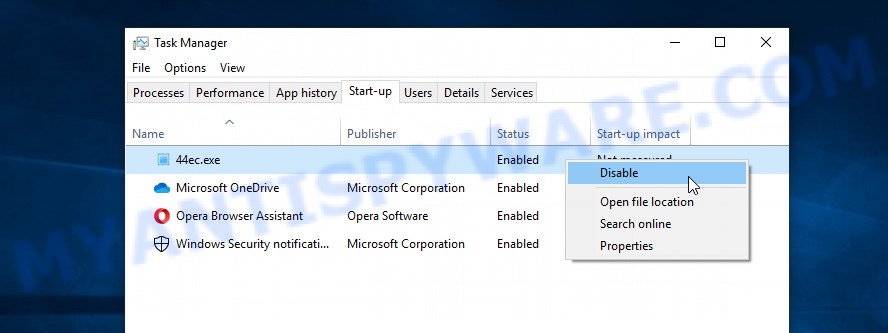
Close Task Manager.
Delete Ribd virus Task
Type “Task Scheduler” in the search bar. Click Task Scheduler app in the search results. Click “Task Scheduler Library” in the left panel. On the right panel, right-click to “Time Trigger Task” and select Delete.
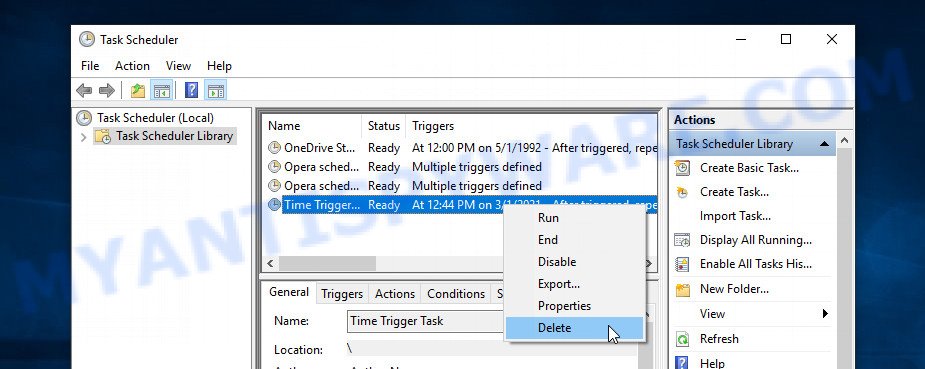
Close Task Scheduler.
Remove Ribd virus (ransomware)
Run Task Manager and select the “Start-Up” tab. Right click to the Ribd ransomware Start-Up entry and select Open File Location as shown below.

A directory containing one file will open in front of you, this file is the Ribd virus (ransomware). It needs to be removed. If you try to delete it immediately, then you will not succeed, since this file is protected from deletion.
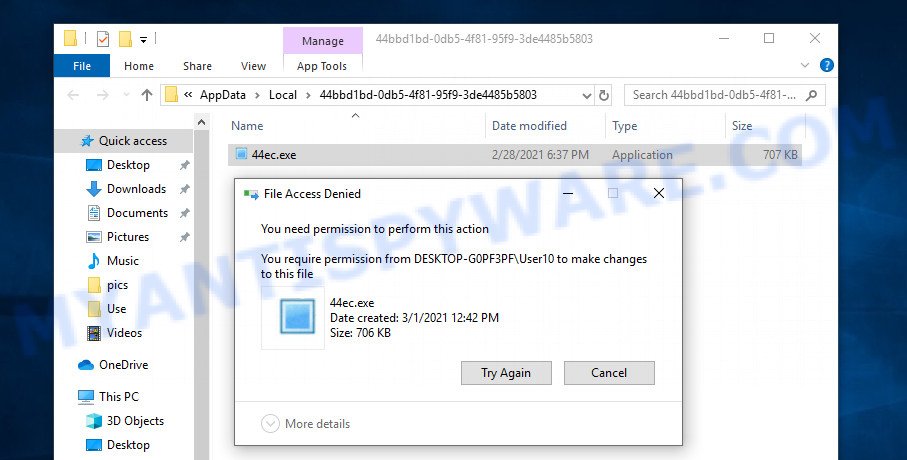
To delete this file, you need to do the following. Right-click on the file, select Properties. In the window that opens, select Security tab. Next, click the Advanced button below. A window will open as shown in the following example.
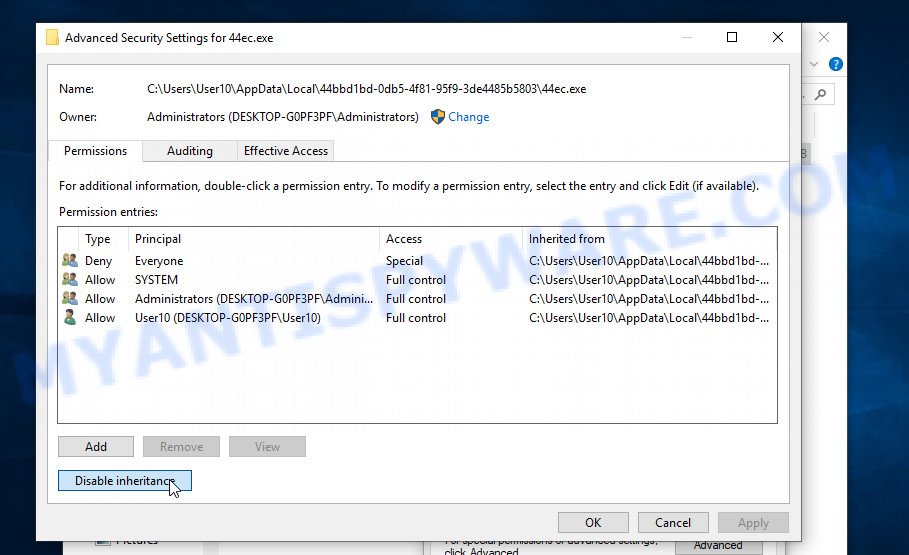
Click Disable inheritance. In the Block inheritance dialog box that opens, select the first item (Convert inherited permissions…) as shown below.
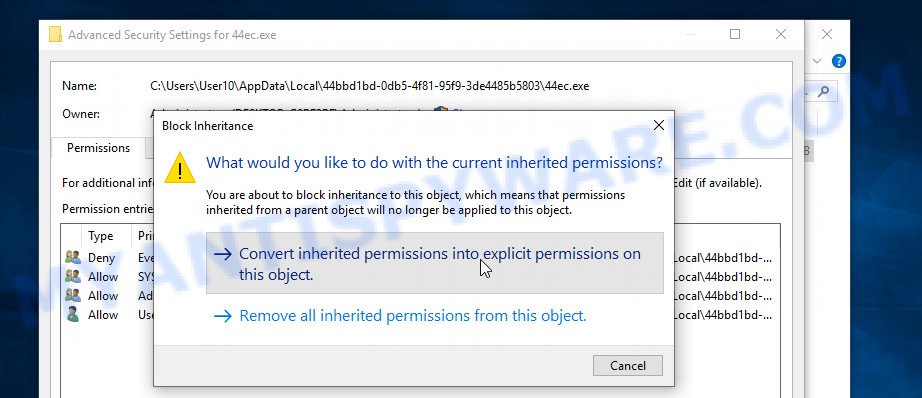
In the Permission entries list, select “Deny Everyone”, click Remove button and then OK. Close the file properties window. You should now be able to remove the Ribd ransomware File. Right-click on the file and select Delete.
Scan computer for malware
Zemana Anti Malware (ZAM) is a complete package of anti-malware utilities that can help you remove Ribd virus (ransomware). Despite so many features, it does not reduce the performance of your computer. Zemana can uninstall almost all the types of malware including ransomware, trojans, worms, adware software, hijackers, potentially unwanted programs and other security threats. Zemana has real-time protection that can defeat most malware and ransomware virus. You can run Zemana Anti Malware with any other antivirus without any conflicts.
Zemana Anti-Malware (ZAM) can be downloaded from the following link. Save it on your Windows desktop or in any other place.
165079 downloads
Author: Zemana Ltd
Category: Security tools
Update: July 16, 2019
After downloading is complete, close all windows on your personal computer. Further, run the install file named Zemana.AntiMalware.Setup. If the “User Account Control” dialog box pops up as shown on the screen below, click the “Yes” button.

It will show the “Setup wizard” that will assist you install Zemana Anti Malware on the PC. Follow the prompts and do not make any changes to default settings.

Once install is done successfully, Zemana will automatically run and you can see its main window as displayed on the screen below.

Next, click the “Scan” button to begin checking your computer for the Ribd ransomware virus and other security threats. While the Zemana Anti Malware (ZAM) tool is checking, you can see count of objects it has identified as being infected by malware.

Once the scan get finished, you can check all items found on your computer. Review the report and then click “Next” button.

The Zemana Anti Malware will remove Ribd ransomware, other kinds of potential threats like malware and trojans. When that process is done, you may be prompted to restart your computer.
In order to be 100% sure that the computer no longer has the Ribd crypto virus, we recommend using the Kaspersky virus removal tool (KVRT). It is a free portable tool that scans your computer for spyware, ransommware, adware, potentially unwanted software, trojans, worms, malicious software and helps uninstall them easily. Moreover, it’ll also help you delete any other security threats for free.
Download Kaspersky virus removal tool (KVRT) from the following link. Save it on your Windows desktop or in any other place.
129307 downloads
Author: Kaspersky® lab
Category: Security tools
Update: March 5, 2018
Once downloading is done, double-click on the KVRT icon. Once initialization process is complete, you’ll see the Kaspersky virus removal tool screen as shown on the screen below.

Click Change Parameters and set a check near all your drives. Click OK to close the Parameters window. Next click Start scan button to perform a system scan with this tool for the Ribd ransomware virus and other known infections. This procedure may take some time, so please be patient. When a malicious software, adware or potentially unwanted apps are found, the number of the security threats will change accordingly.

After that process is complete, you’ll be displayed the list of all detected threats on your PC as shown in the following example.

Review the scan results and then press on Continue to start a cleaning task.
How to decrypt .ribd files
Files with the extension ‘ribd’ are encrypted files. To decrypt them, you need to use a decryptor and a unique key. Fortunately, there is a free Ribd File Decrypt Tool that can decrypt .ribd files. This decryptor is compatible with all modern versions of the Windows OS and can decrypt files regardless of their size and type.

Ribd File Decrypt Tool (STOP Djvu decryptor)
To decrypt .ribd files, use Ribd File Decrypt Tool
- Download Ribd File Decrypt Tool from the following link.
STOP Djvu decryptor - Scroll down to ‘New Djvu ransomware’ section.
- Click the download link and save the decrypt_STOPDjvu.exe file to your desktop.
- Run decrypt_STOPDjvu.exe, read the license terms and instructions.
- On the ‘Decryptor’ tab, using the ‘Add a folder’ button, add the directory or disk where the encrypted files are located.
- Click the ‘Decrypt’ button.
Ribd File Decrypt Tool is a free software that can decrypt the encrypted files only in some cases, when the files were encrypted with an ‘offline key’. If the files were encrypted with an ‘online key’, then they cannot be decrypted. The reason for this is that the decryption key is in the hands of criminals and this key can not be determined. This does not mean that if your files are encrypted with an online key, then their contents are lost forever. Fortunately, there are several ways to recover encrypted files. These methods do not involve the use of decryption and therefore can be used in any case, no matter what key the ransomware used to encrypt files.
How to find out which key was used to encrypt files
Since STOP (Ribd) decryptor only decrypts files encrypted with an offline key, each Ribd’s victim needs to find out which key was used to encrypt the files. Determining the type of key used is not difficult. Below we give two ways. Use any of them.

Personal ID is highlighted here
Find out the type of key using ‘_readme.txt’ file
- Open the ransom demand message (‘_readme.txt’ file).
- Scroll down to the end of the file.
- There you will see a line with the text ‘Your personal ID’.
- Below is a line of characters that starts with ‘0284’ – this is your personal id.
Find out the type of key using ‘PersonalID.txt’ file
- Open disk C.
- Open directory ‘SystemID’.
- Open file named ‘PersonalID.txt’. This file lists ‘Personal ID’s that match the keys that the virus used to encrypt files.
The ‘Personal ID’ is not a key, it is an identifier related to a key that was used to encrypt files. If the ID ends with ‘t1’, then the files are encrypted with an offline key. If the ID does not end with ‘t1’, Ribd virus used an online key. If you could not figure out how to determine which key was used to encrypt files, then we can help. Just write a request here or in the comments below.
Ribd File Decrypt Tool : “No key for New Variant online ID”

If, when you try to decrypt .ribd files, Ribd File Decrypt Tool reports:
No key for New Variant online ID: *
Notice: this ID appears to be an online ID, decryption is impossible
It means that your files are encrypted with an ‘online key’ and their decryption is impossible, since only the Ribd authors have the key necessary for decryption. In this case, you need to use alternative methods listed below to restore the contents of encrypted files.
Ribd File Decrypt Tool : “No key for New Variant offline ID”

If, during decryption of .ribd files, Ribd File Decrypt Tool reports:
No key for New Variant offline ID: *t1
Notice: this ID appears be an offline ID, decryption MAY be possible in the future.
It means the following: your files are encrypted with an ‘offline key’, but the key itself has not yet been obtained by security researchers, in this case, you need to be patient and wait a while, in addition, you can also use alternative ways for recovering encrypted data.
If for some reason you were unable to decrypt the encrypted files, then We recommend to follow the news on our Facebook or YouTube channels. So you ‘ll know right away that it ‘s possible to decrypt .ribd files.
This video step-by-step guide will demonstrate How to remove Ribd virus, Decrypt/Recover .ribd files.
How to restore .ribd files
Fortunately, there are some alternative ways to recover encrypted files. Each of them does not suggest the use of a decryptor and a key, so these methods will suit all ransomware victims. In addition, the use of these methods will not affect in any way the decryption of files using a free decryptor. The only thing is that before you proceed with file recovery, be sure to check your computer for malware, you need to be 100% sure that the ransomware has been completely removed. To find and remove Ribd virus use free malware removal tools.
Use shadow copies to restore .ribd files
A free utility called ShadowExplorer is a simple way to use the ‘Previous Versions’ feature of Microsoft Windows 10 (8, 7 , Vista). You can restore photos, documents and music encrypted by the Ribd crypto malware from Shadow Copies for free.
Installing the ShadowExplorer is simple. First you will need to download ShadowExplorer on your Microsoft Windows Desktop from the following link.
439691 downloads
Author: ShadowExplorer.com
Category: Security tools
Update: September 15, 2019
When the downloading process is finished, open a directory in which you saved it. Right click to ShadowExplorer-0.9-portable and select Extract all. Follow the prompts. Next please open the ShadowExplorerPortable folder similar to the one below.

Double click ShadowExplorerPortable to run it. You will see the a window as displayed in the following example.

In top left corner, select a Drive where encrypted personal files are stored and a latest restore point as shown on the image below (1 – drive, 2 – restore point).

On right panel look for a file that you want to restore, right click to it and select Export as on the image below.

This video step-by-step guide will demonstrate How to recover encrypted files using Shadow Explorer.
Recover .ribd files with PhotoRec
The last chance to restore encrypted files to their original state is using data recovery tools. We recommend a free tool called PhotoRec. It has all the necessary functions to restore the contents of encrypted files. It helped many victims recover data when it seemed like there was no more hope.
Download PhotoRec on your Microsoft Windows Desktop from the following link.
When the downloading process is finished, open a directory in which you saved it. Right click to testdisk-7.0.win and select Extract all. Follow the prompts. Next please open the testdisk-7.0 folder as on the image below.

Double click on qphotorec_win to run PhotoRec for Microsoft Windows. It will open a screen as shown on the image below.

Select a drive to recover as shown below.

You will see a list of available partitions. Select a partition that holds encrypted personal files as shown in the following example.

Click File Formats button and specify file types to recover. You can to enable or disable the restore of certain file types. When this is done, press OK button.

Next, click Browse button to choose where restored photos, documents and music should be written, then click Search. We strongly recommend that you save the recovered files to an external drive.

Count of recovered files is updated in real time. All recovered documents, photos and music are written in a folder that you have selected on the previous step. You can to access the files even if the recovery process is not finished.
When the restore is complete, click on Quit button. Next, open the directory where recovered personal files are stored. You will see a contents like below.

All restored files are written in recup_dir.1, recup_dir.2 … sub-directories. If you’re searching for a specific file, then you can to sort your recovered files by extension and/or date/time.
This video step-by-step guide will demonstrate How to recover encrypted files using PhotoRec.
How to protect your computer from Ribd ransomware
Most antivirus applications already have built-in protection system against the ransomware virus. Therefore, if your computer does not have an antivirus program, make sure you install it. As an extra protection, use the HitmanPro.Alert. All-in-all, HitmanPro.Alert is a fantastic utility to protect your personal computer from any ransomware. If ransomware is detected, then HitmanPro.Alert automatically neutralizes malware and restores the encrypted files. HitmanPro.Alert is compatible with all versions of MS Windows operating system from Microsoft Windows XP to Windows 10.
Download HitmanPro.Alert from the link below. Save it on your Desktop.
After the downloading process is complete, open the folder in which you saved it. You will see an icon like below.

Double click the HitmanPro.Alert desktop icon. After the utility is started, you will be displayed a window where you can choose a level of protection, like the one below.

Now press the Install button to activate the protection.
Finish words
This guide was created to help all victims of the Ribd ransomware virus. We tried to give answers to the following questions: how to remove ransomware; how to decrypt .ribd files; how to recover files, if Ribd File Decrypt Tool does not help; what is an online key and what is an offline key. We hope that the information presented in this manual has helped you.
If you have questions, then write to us, leaving a comment below. If you need more help with Ribd related issues, go to here.




















